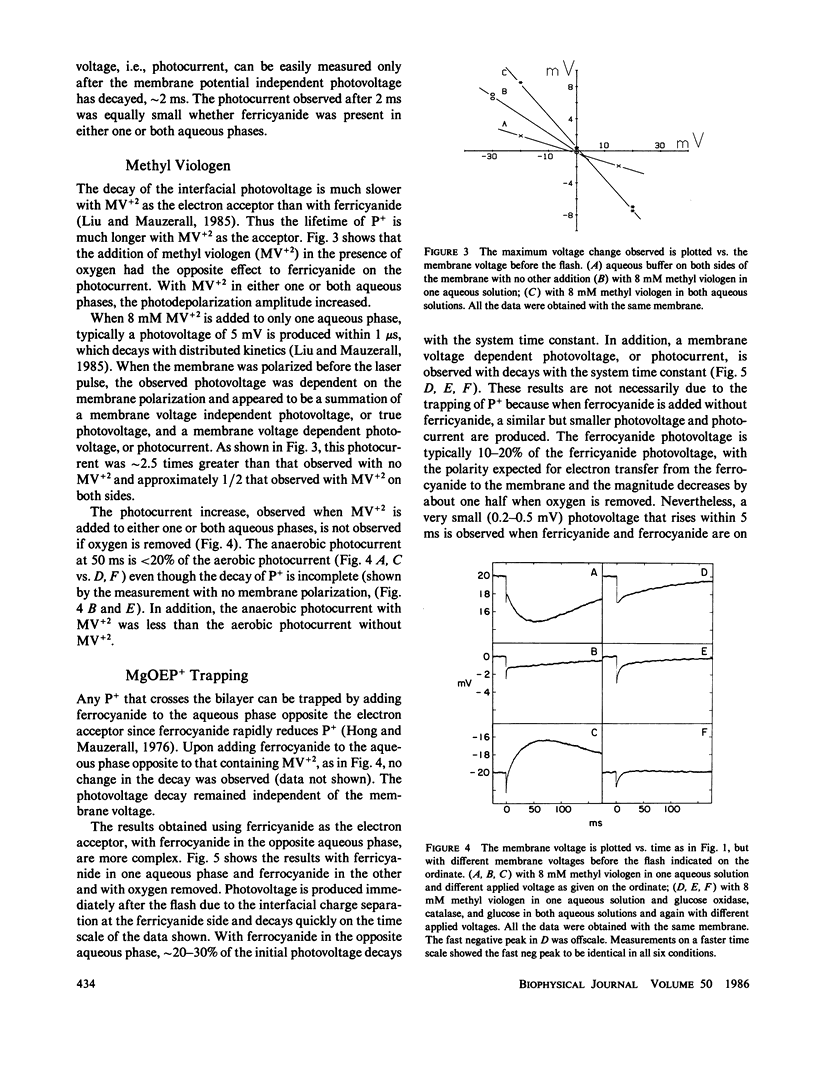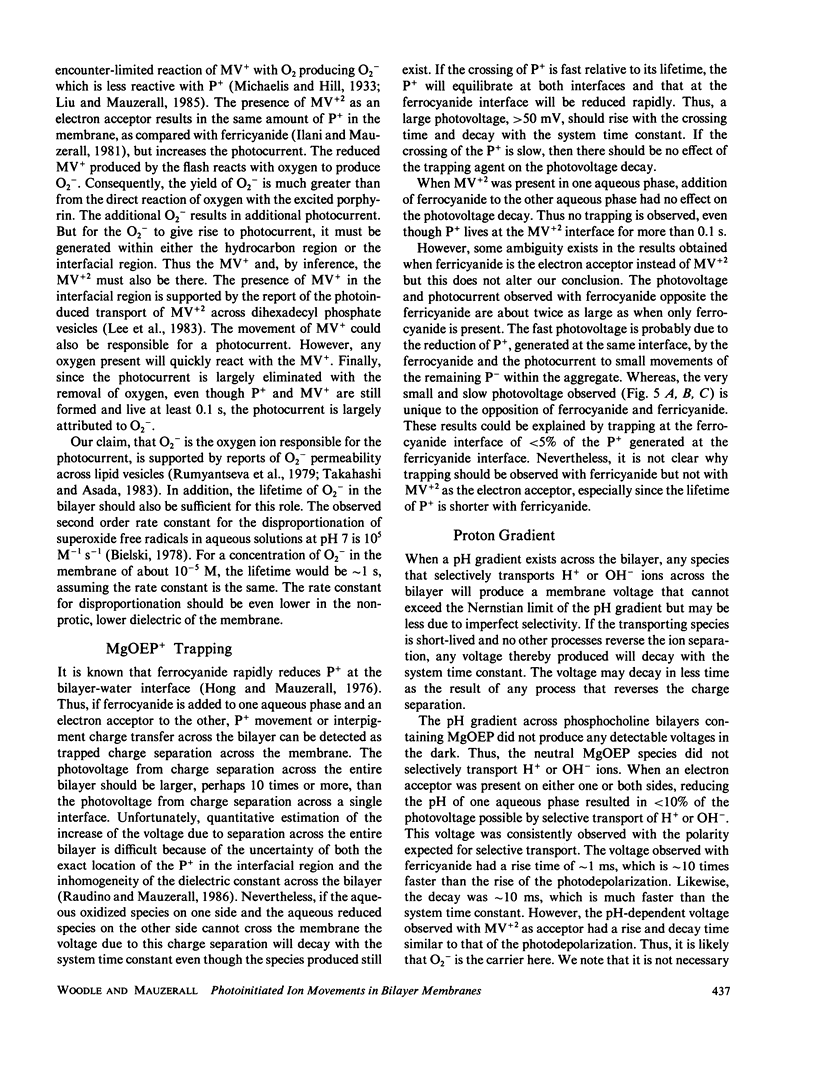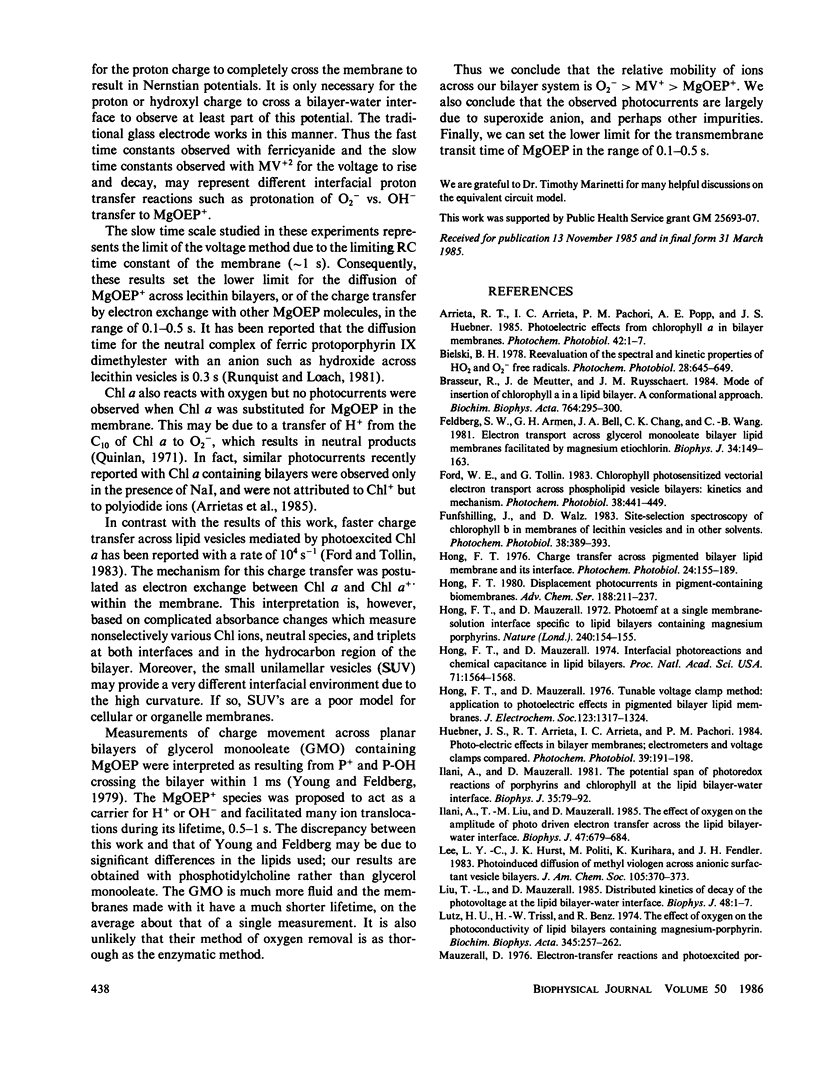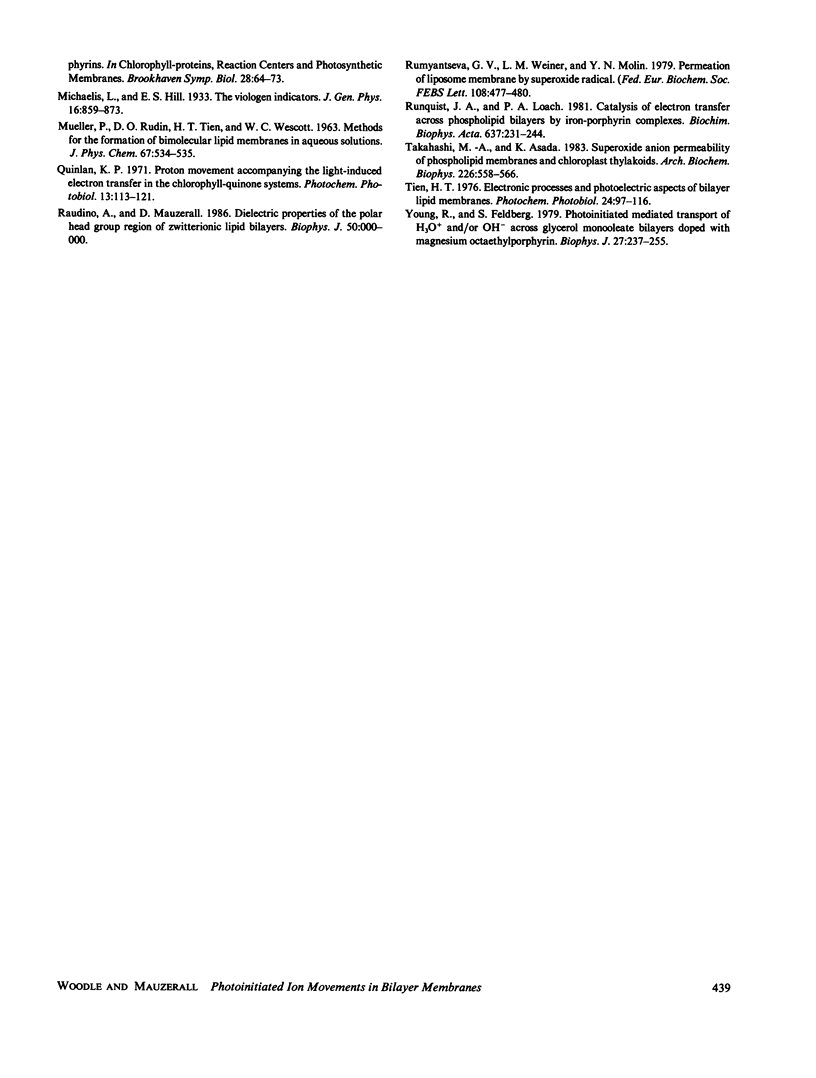Abstract
A photocurrent produced by planar lipid bilayers containing Mg-octaethylporphyrin in the presence of oxygen has been investigated to determine if the current is due to movement of the MgOEP+ ion in the bilayer. Photoexcitation of the MgOEP is known to produce MgOEP+ in the bilayer when an electron acceptor is present. However, the aqueous electron acceptors ferricyanide and methyl viologen (MV+2) have opposite effects on the photocurrent. Ferricyanide decreases the photo current, even in the presence of oxygen, whereas methyl viologen increases the photocurrent, but only when oxygen is present. We attribute most of the photocurrent to the movement of superoxide anion. The difference in effect between ferricyanide and methyl viologen is attributed to the different rates of reduction of O2 by reduced MV+ (fast) vs. ferrocyanide (slow) and the known competition between ferricyanide and oxygen as the acceptor for the photoexcited porphyrin. It is inferred that most of the MgOEP is localized in the polar region of the lipid bilayer. Addition of ferrocyanide to the aqueous phase on one side of the bilayer, to trap MgOEP+ produced on the other side by MV+2, fails to increase the lifetime of the photovoltage. With a pH gradient across the bilayer, we observed only 5% of the photovoltage expected for the selective transport of H+ or OH- by MgOEP+. Thus, these measurements set the lower limit for the cross bilayer transit time of MgOEP+ or its charge in the range of 0.1-0.5 s.
Full text
PDF








Selected References
These references are in PubMed. This may not be the complete list of references from this article.
- Feldberg S. W., Armen G. H., Bell J. A., Chang C. K., Wang C. B. Electron transport across glycerol monooleate bilayer lipid membranes facilitated by magnesium etiochlorin. Biophys J. 1981 Apr;34(1):149–163. doi: 10.1016/S0006-3495(81)84842-4. [DOI] [PMC free article] [PubMed] [Google Scholar]
- Hong F. T. Charge transfer across pigmented bilayer lipid membrane and its interfaces. Photochem Photobiol. 1976 Aug;24(2):155–189. doi: 10.1111/j.1751-1097.1976.tb06809.x. [DOI] [PubMed] [Google Scholar]
- Hong F. T., Mauzerall D. Interfacial photoreactions and chemical capacitance in lipid bilayers. Proc Natl Acad Sci U S A. 1974 Apr;71(4):1564–1568. doi: 10.1073/pnas.71.4.1564. [DOI] [PMC free article] [PubMed] [Google Scholar]
- Hong F. T., Mauzerall D. Photoemf at a single membrane-solution interface specific to lipid bilayers containing magnesium porphyrins. Nat New Biol. 1972 Nov 29;240(100):154–155. doi: 10.1038/newbio240154a0. [DOI] [PubMed] [Google Scholar]
- Ilani A., Liu T. M., Mauzerall D. The effect of oxygen on the amplitude of photodriven electron transfer across the lipid bilayer-water interface. Biophys J. 1985 May;47(5):679–684. doi: 10.1016/S0006-3495(85)83964-3. [DOI] [PMC free article] [PubMed] [Google Scholar]
- Ilani A., Mauzerall D. The potential span of photoredox reactions of porphyrins and chlorophyll at the lipid bilayer-water interface. Biophys J. 1981 Jul;35(1):79–92. doi: 10.1016/S0006-3495(81)84775-3. [DOI] [PMC free article] [PubMed] [Google Scholar]
- Liu T. M., Mauzerall D. Distributed kinetics of decay of the photovoltage at the lipid bilayer-water interface. Biophys J. 1985 Jul;48(1):1–7. doi: 10.1016/S0006-3495(85)83755-3. [DOI] [PMC free article] [PubMed] [Google Scholar]
- Lutz H. U., Trissl H. W., Benz R. The effect of oxygen on the photoconductivity of lipid bilayers containing magnesium-porphyrin. Biochim Biophys Acta. 1974 Apr 29;345(2):257–262. doi: 10.1016/0005-2736(74)90264-8. [DOI] [PubMed] [Google Scholar]
- Mauzerall D. Electron transfer reactions and photoexcited porphyrins. Brookhaven Symp Biol. 1976 Jun 7;(28):64–73. [PubMed] [Google Scholar]
- Rumyantseva G. V., Weiner L. M., Molin Y. N., Budker V. G. Permeation of liposome membrane by superoxide radical. FEBS Lett. 1979 Dec 15;108(2):477–480. doi: 10.1016/0014-5793(79)80592-x. [DOI] [PubMed] [Google Scholar]
- Runquist J. A., Loach P. A. Catalysis of electron transfer across phospholipid bilayers by iron-porphyrin complexes. Biochim Biophys Acta. 1981 Sep 14;637(2):231–244. doi: 10.1016/0005-2728(81)90162-6. [DOI] [PubMed] [Google Scholar]
- Takahashi M. A., Asada K. Superoxide anion permeability of phospholipid membranes and chloroplast thylakoids. Arch Biochem Biophys. 1983 Oct 15;226(2):558–566. doi: 10.1016/0003-9861(83)90325-9. [DOI] [PubMed] [Google Scholar]
- Tien H. T. Electronic processes and photoelectric aspects of bilayer lipid membranes. Photochem Photobiol. 1976 Aug;24(2):97–116. doi: 10.1111/j.1751-1097.1976.tb06806.x. [DOI] [PubMed] [Google Scholar]
- Young R. C., Feldberg S. W. Photoinitiated mediated transport of H3O+ and/or OH- across glycerol monooleate bilayers doped with magnesium octaethylporphyrin. Biophys J. 1979 Aug;27(2):237–255. doi: 10.1016/S0006-3495(79)85214-5. [DOI] [PMC free article] [PubMed] [Google Scholar]


